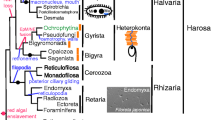Abstract
The colourless, nonphotosynthetic protist Astasia longa is phylogenetically related to Euglena gracilis. The 73-kb plastid DNA (ptDNA) of A. longa is about half the size of most chloroplast DNAs (cpDNAs). More than 38 kb of the Astasia ptDNA sequence has been determined. No genes for photosynthetic function have been found except for rbcL. Identified genes include rpoB, tufA, and genes coding for three rRNAs, 17 tRNAs, and 13 ribosomal proteins. Not only is the nucleotide sequence of these genes highly conserved between A. longa and E. gracilis, but a number of these genes are clustered in a similar fashion and have introns in the same positions in both species. The results further support the idea that photosynthetic genes normally encoded in cpDNA have been preferentially lost in Astasia, but that the chloroplast genes coding for components of the plastid translational apparatus have been maintained. This apparatus might be needed for the expression of rbcL and also for that of still unidentified nonphotosynthetic genes of Astasia ptDNA.
Similar content being viewed by others
References
Chen EY, Seeburg PH (1985) DNA 4:165–170
Christopher DA, Hallick RB (1989) Nucleic Acids Res 17:7591–7608
Christopher DA, Hallick RB (1990) Plant Cell 2:659–671
Christopher DA, Cushman JC, Price CA, Hallick RB (1988) Curr Genet 14:275–286
De Pamphilis CW, Palmer JD (1990) Nature 348:337–339
Dix KP, Rawson JRY (1983) Curr Genet 7:265–272
Fukuzawa H, Kohchi T, Sano T, Shirai H, Umesono K, Inokuchi H, Ozeki H, Ohyama K (1988) J Mol Biol 203:333–351
Gingrich JC, Hallick RB (1985) J Biol Chem 260:16156–16161
Graf L, Kössel H, Stutz E (1980) Nature 286:908–910
Hallick RB, Buetow DE (1989) In: Buetow DE (ed) The biology of Euglena, vol 4. Academic Press, San Diego, pp 351–414
Hallick RB, Hong L, Drager RG, Favreau MR, Monfort A, Orsat B, Spielmann A, Stutz E (1993) Nucleic Acids Res 21:3537–3544
Kössel H, Natt E, Strittmatter G, Fritzsche E, Gozdzicka-Jozefiak A, Przybyl D (1985) In: Vloten-Doting L van, Groot GSP, Hall TC (eds) Molecular form and function of the plant genome. Plenum Press, New York, pp 183–198
Kröger M, Wahl R, Schachtel G, Rice P (1992) Nucleic Acids Res 20:2119–2145
Lipman DJ, Pearson WR (1985) Science 227:1435–1441
Manzara T, Hallick RB (1988) Nucleic Acids Res 16:9866
Manzara TB, Hu J, Price CA, Hallick RB (1987) Plant Mol Biol 8: 327–336
Monfort A, Rutti B, Stutz E (1986) Nucleic Acids Res 14:3971
Montandon PE, Vasserot A, Stutz E (1986) Curr Genet 11:35–39
Ohyama H, Fukuzawa H, Kohchi T, Shirai H, Sano S, Sano T, Umesono K, Shiki Y, Takeuchi M, Chang Z, Aota S, Inokuchi H, Ozeki H (1986) Nature 322:572–574
Orozco ME, Rushlow KE, Dodd JR, Hallick RB (1980) J Biol Chem 255:10997–11003
Pringsheim EG (1942) New Phytol 41:171–205
Roux E, Stutz E (1985) Curr Genet 9:221–227
Sambrook J, Fritsch EF, Maniatis T (1989) Molecular cloning: a laboratory manual. Cold Spring Harbor Laboratory, Cold Spring Harbor, New York
Sanger F, Nicklen S, Coulson AR (1977) Proc Natl Acad Sci USA 74:5463–5467
Shinozaki K, Ohme M, Tanaka M, Wakasugi T, Hayashida N, Matsubayashi T, Zaita N, Chunwongse J, Obokata J, Yamaguchi-Shinozaki K, Ohto C, Torazawa K, Meng BY, Sugita M, Deno H, Kamagashira T, Yamada K, Kusuda J, Takaiwa F, Kato A, Shimada H, Sugiura M (1986) EMBO J 5:2043–2049
Siemeister G, Hachtel W (1989) Curr Genet 15:435–441
Siemeister G, Hachtel W (1990a) Plant Mol Biol 14:825–833
Siemeister G, Hachtel W (1990b) Curr Genet 17:433–438
Siemeister G, Buchholz C, Hachtel W (1990a) Mol Gen Genet 220: 425–432
Siemeister G, Buchholz C, Hachtel W (1990b) Curr Genet 18: 457–464
Sprinzl M, Hartmann T, Weber J, Blank J, Zeidler R (1989) Nucleic Acids Res 17:r1-r172
Subramanian AR, Steinmetz A, Bogorad L (1983) Nucleic Acids Res 11:5277–5286
Sugiura M (1992) Plant Mol Biol 19:149–168
Tabor S, Richardson CC (1987) Proc Natl Acad Sci USA 84: 4767–4771
Wolfe KH, Morden CW, Palmer JD (1992) Proc Natl Acad Sci USA 89:10648–10652
Yoshimura M, Kimura M, Ohno M, Inokuchi H, Ozeki H (1984) J Mol Biol 177:609–625
Zurawski G, Zurawski SM (1985) Nucleic Acids Res 13:4521–4526
Author information
Authors and Affiliations
Additional information
These sequence data will appear in the EMBL/Gen Bank/DDBJ nucleotide sequence data base under accession numbers X75651, X75652 and X75653
Rights and permissions
About this article
Cite this article
Gockel, G., Hachtel, W., Baier, S. et al. Genes for components of the chloroplast translational apparatus are conserved in the reduced 73-kb plastid DNA of the nonphotosynthetic euglenoid flagellate Astasia longa . Curr Genet 26, 256–262 (1994). https://doi.org/10.1007/BF00309557
Received:
Accepted:
Issue Date:
DOI: https://doi.org/10.1007/BF00309557




